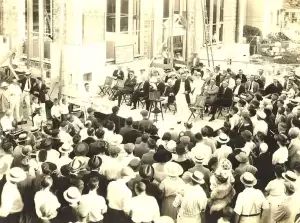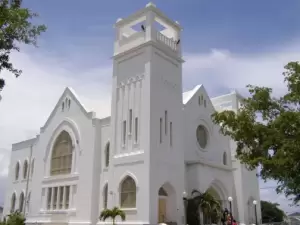West Palm Beach Buildings

Many of the existing buildings in downtown West Palm Beach were constructed during the boom years. The neo-classical American National Bank Building built in 1921 was the first building in the city to be designed by architects Henry Harvey and Phillips Clarke. A year later, the team designed the Guaranty Building at 120 Olive Avenue for Palm Beach Guaranty Company. At the time, the seven-story building contained more square footage than any other in Florida.
In 1925 Harvey and Clarke designed the ten-story, 100,000-square foot Comeau Building for financier Alfred J. Comeau, replacing his Comeau Café at 317 Clematis Street. Another Harvey and Clarke design, the Arcade at 300-310 Datura Street, was built by Jack S. Willson from Kentucky. By 1924, at age 31, Willson had a million dollar business; he built homes in the Northwood, El Cid, and Prospect Park subdivisions, as well as apartments and houses in Palm Beach.
Carefree Theatre
In 1939 Elias Chalhub bought an ice cream parlor and coin laundry at South Dixie Highway and Flamingo Drive, West Palm Beach. He expanded it in 1948 into the Carefree Bowling Alley and Theater, where his cousin, Dr. Edward M. Eissey, later recalled earning five cents to place each set of wooden bowling pins; others were happy to do it for nothing. The Carefree grew into a popular 750-seat theater for concerts as well as movies, which was run by promoter Jon Stoll for many years before it closed in 2005.Adjacent to the Miccosukee reservation is the Seminoles’ Big Cypress reservation, in part of Hendry and Broward counties. Although Big Cypress is the largest Seminole reservation (82 square miles), Hollywood, in Broward County, is the most populated and the seat of the Seminoles’ tribal council. The Brighton reservation is northwest of Lake Okeechobee, in Glades County. Other reservations include Immokalee in Collier County, and Tampa in Hillsborough County. The 2000 U.S. Census reported 3,000 Seminoles and Miccosukees on south Florida reservations; they earn money by farming and by operating hotels, casinos, and other tourist attractions.
As in Palm Beach, several new hotels went up. The Holland House at Evernia and Narcissus was razed for the Pennsylvania Hotel, designed by Harvey and Clarke in 1925. A year later their 7-story plan for the Dixie Court Hotel was built at Poinsettia (Dixie Highway) and 2nd Street, now the site of the 1990 courthouse. Hotel Monterey on Clematis Street and Sapodilla, designed by William Manly King in 1926, rented rooms for $2 to $8 per night; a state office building now occupies the site.
The Chillingworth family leased their lot at the southwest corner of Olive and Datura to developer George W. Harvey for 99 years, for more than $3 million. In 1927 Harvey built the 14-story Harvey Building on the site, which towered seven stories higher than any other in West Palm Beach.

Courtesy Richard Marconi
The African American Northwest neighborhood, developed primarily in the teens and 1920s, later became the city’s first district to be listed in the National Register of Historic Places. The home of Dr. Alice F. Mickens (1917) at 801 Fourth Street is also individually listed in the Register. The Gwen Cherry House (1925) at 625 Division Avenue was designed by Hazel Augustus, Palm Beach County’s first black architect, as was the Payne A. M. E. Chapel (1924), 801 Ninth Street.
West Palm Beach Overrun
By September 1925, with the boom at its peak in West Palm Beach, the Palm Beach Post wrote about “employees in all lines of business and hundreds of newcomers daily arriving in West Palm Beach confronted with what is growing to be the most acute housing shortage in the city’s history.” A shortage of labor developed because workmen could not find a place to stay. Many had already set up camps around the city, and sanitation was a concern.
Southern Bell leased the former Metcalf home to convert into a dormitory. The county school board asked the city to build 12 temporary houses on school property for teachers. People flocked to city hall, where the city manager was hoping to get permission to erect a tent city and to exceed building codes.
The effects of the railroad embargo reached West Palm Beach in December, and the labor and housing shortage was worsened by the shortage of building materials. Tents were temporarily allowed outside the fire zones if they met the sanitary code, but all tents required fire and health department approval.

